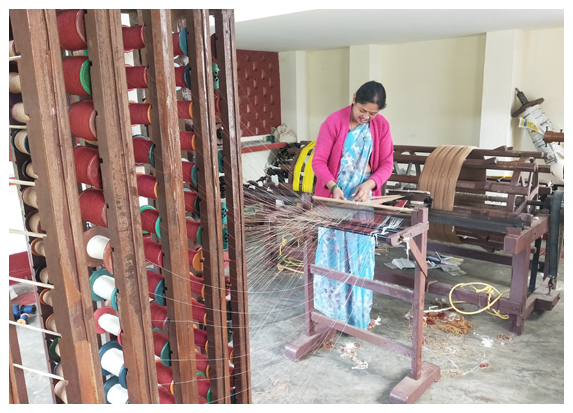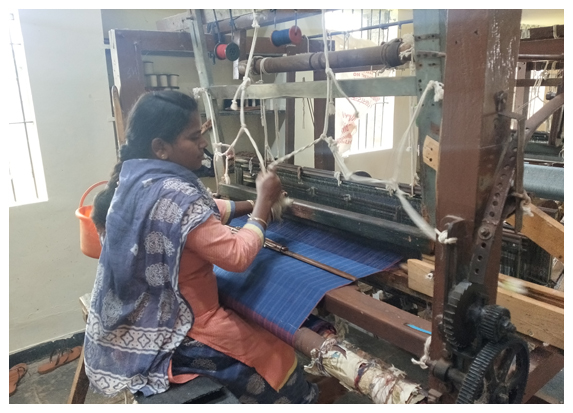India is home to 95% of the world’s total handwoven fabric. And handloom weaving is the second largest employment sector in the country next only to agriculture. More than 40 lakh households are engaged in handloom weaving and its allied occupations - Hand Spinning, Tailoring, Hand Embroidery, Dyeing, Tie & Dye etc. Handloom artists are repositories of traditional knowledge and skill. Each regional handloom cluster is unique in itself. It involves multiple-skills, process and people.

The beauty of handspun, handwoven textiles is in the texture and inherent inequality. It is like each piece is almost customized.
A handwoven fabric is woven manually on a loom that is operated by hand, and hence the name handloom. Any fabric is produced by the interlacement of yarns – the warp which makes the length of the fabric and the weft which interlaces/ interlocks with the warp and makes the width of the fabric. Weaving is this interlacement of the warp and weft. The most common hand loom used by weavers is a pit loom, where the weaver sits on the floor with his/her feet inside a pit.
There is a difference between Khaddar/Khadi products and Handloom products. Though the process of weaving is similar, the difference is in the yarn used. Khaddar/Khadi products use hand-spun yarn whereas Handloom uses mill-spun yarn. All Khaddar/Khadi is handloom fabric, but all handloom fabric is not Khaddar/Khadi.
Handloom weaving is a community activity where weavers mostly work from their homes making it a village industry or ‘gramodyog’ – it is not possible for one weaver to weave just by him/herself. The basic weaver household may consist of at least one man and a woman working together – one predominantly doing all the pre-loom and the other weaving. Some may choose to get the warp done by some others in the neighbourhood, thus generating another local livelihood.
India is home to 95% of the world’s total handwoven fabric. And handloom weaving is the second largest employment sector in the country next only to agriculture. More than 40 lakh households are engaged in handloom weaving and its allied occupations - Hand Spinning, Tailoring, Hand Embroidery, Dyeing, Tie & Dye etc.
So, when you buy a handloom or handwoven fabric, you can be assured that every square cm of the fabric has been touched and fashioned by many a human hand into the lovely fabric that you are holding! Handloom fabric celebrates the human hand!
We have more than 3 million people in India alone, who are repositories of traditional knowledge and skill on how to make fabric entirely by hand, in an age where everything is mechanized and industrialized. It is for us, as consumers, to recognize and value the potential of the human hand.
Like all handmade stuff weaving too is customized and diversified. There is so much diversity and so man styles and Gharanas here too.
Each regional handloom cluster is unique in itself. It involves multiple-skills, process and people. A Master weaver would need herders, farmers or cocoon rearers to supply raw material; carpenters to align the loom; Women to prepare raw cotton, wind bobbin, Prepare warp, starch, then dry and wash. Those multiple hands are generally forgotten by economists and us consumers.
Hand made products like these are the most sustainable, so light on Mother Earth, use less energy, resources and also do not pollute. Unlike mill made cloth using powerlooms, which requires a huge investment, infrastructure and electricity.
With a single powerloom you will be able to mass produce several meters of cloth per day, but at the same time you will find that you have displaced 14 handlooms and in turn 14 weaver households. Thereby sowing the seed towards destruction of a beautiful craft that is keeping the villages of India alive.

The process of hand spinning saves nearly 40 gallons of water and uses less electricity.
Hand-weaving is an age-old, intensely valuable, but fragile skill-set and knowledge system, which may not survive the onslaught of Industrialisation, Globalisation, and Rural Migration. Textile traditions, however beautiful and integral to our culture, will not survive unless the people who craft them also find their survival worthwhile.
Over decades we have taken the handweaver for granted without investing in them and not paying them fair or dignified compensation.
As consumers let’s be conscious of the handmade artisanal products and patronize them for more reasons.